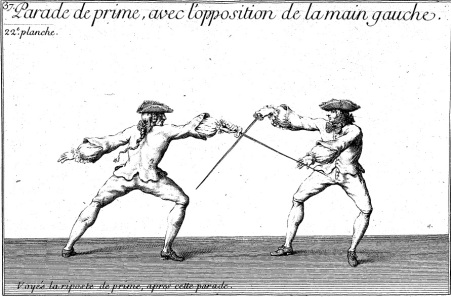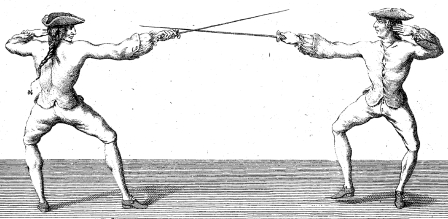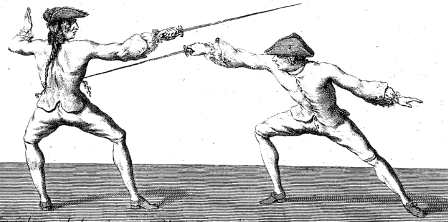In the autumn of 2011 we started our class with an introduction to classical foil fencing. Until April 2012 we learned the fundamental fencing techniques: leg work drills, thrusts, parries and their ripostes, simple feints. Our smallswords arrived after the Easter Holiday break. Since then we have been concentrating on smallsword fencing, building on top of the foil fencing skills acquired so far. This is a brief summary of the techniques we have covered.
The thrusts
The two main thrusts or coups of smallsword fencing are the thrust in tierce and the thrust in quarte. All other thrusts in smallsword fencing are derived from these two:
- the thrust in seconde in the low line with hand in pronation
- the low quarte thrust (or quarte coupée thrust)
- the flanconnade („quarte flanconnade“ or „quarte revers“)
- the quinte or octave thrust in the low outside line with hand in supination
- and the thrust in quarte over the arm.
Every thrust should be delivered directly (coup droit), along the blade fort-to-feeble, with a disengagement, with an appell, with a beat or a combination thereof.
The parries
„Each thrust has its parry“ („chaque botte a sa parade“) as Angelo puts it:
- The quarte against thrusts into the high inside line
- The tierce parry against thrusts into the high outside line
- Seconde parry against thrusts into the low lines
- The half-circle (high septime) parry against thrusts into both the high and low inside lines.
Beside the simple parries there also exist the counter-disengages and the counter-parries, of which we have covered the counter-in-quarte (the most useful one) and the counter-in-tierce.
Parries we have only superficially covered are the quarte over the arm and the prime.
All parries are used both to deflect the opponent’s blade and to secure the opponent’s sword after hitting him with a thrust.
The ripostes
„Each parry has its riposte“ as Angelo says („chaque parade a sa riposte“):
- the return in tierce or second after the tierce parry
- the return in quarte inside (with/without opposition of the left hand) after the quarte parry
- the flanconnade as return after the quarte parry
- the return in seconde after the seconde parry
- the return in quarte inside with opposition of the left hand after the half-circle parry
We have also looked into the concept of the „indirect riposte“ (a more modern term), the quarte coupée to avoid the quarte parry as a counter to our riposte in particular.
The Feints and half-thrusts (demi-bottes)
- feint quarte inside to push quarte over the arm
- feint tierce or quarte over the arm to push quarte inside
- feint to the head in tierce to push seconde
- feint inside to push quinte on the half-circle parry
- feint quarte inside to push low quarte on the quarte parry
Crossing and binding
There are two crossings that we have covered:
- tierce to half-circle („inside flanconnade“)
- quarte to seconde („seconde flanconnade“).
The latter we have applied as a means to disarm the opponent, in particular after a quarte parry. If the crossing fails to disarm the opponent it at least creates an opening wide enough to push a safe seconde.
Both crossings are very useful to gain the opponent’s sword if he eludes our engagement by disengaging. The crossings are especially effective when preceded by a counter-disengage. Example: We try to engage the opponent’s sword in quarte. On the opponent’s disengagement we quickly counter-disengage and cross his sword, thus gaining it in seconde.
The fundamental concepts
Among the fundamental concepts of fencing that we have covered are
- engagements and disengagements
- time
- measure
Other techniques we rotate into our training schedule more or less regularly:
- the pass, the predecessor of our modern fleche
- volting, later called „inquartata“ or „quarting“.
- cuts over the point (as opposed to the cuts under the wrist, e.g. the quarte coupée)
- disarms involving seizing the opponent’s sword
- time thrusts
- reprises




